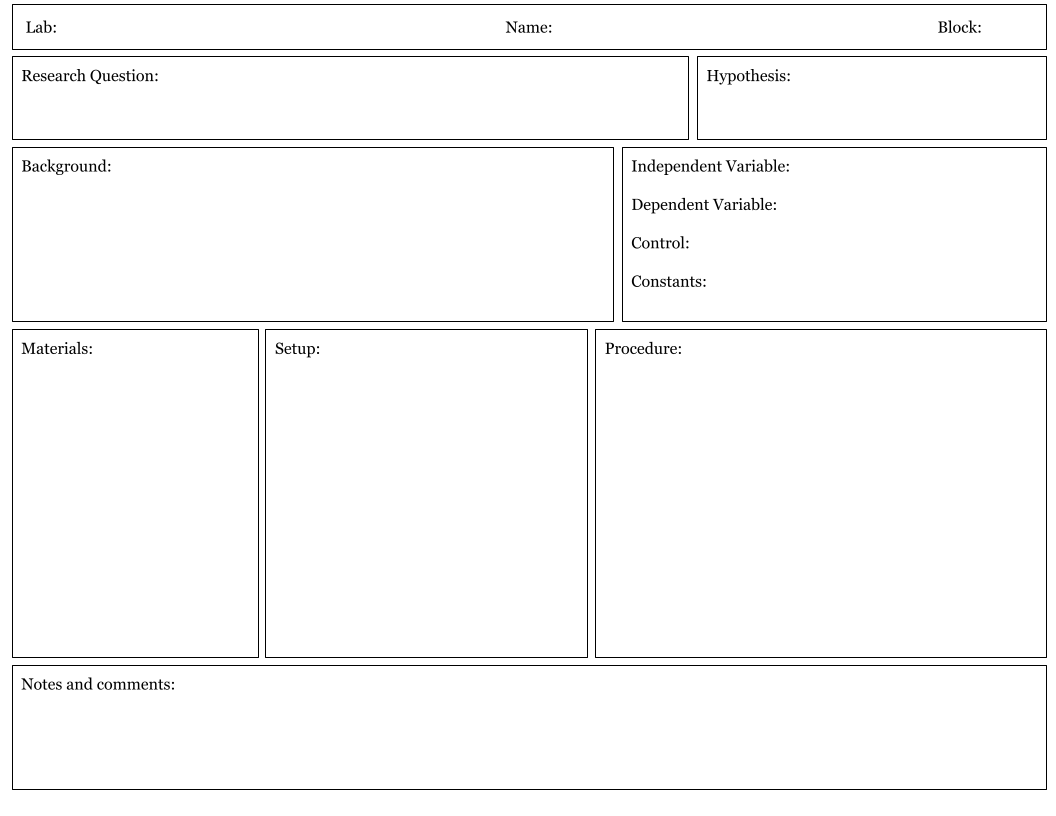A Game Changer for Labs: A Lab Graphic Organizer
Lab days tend to be some of the most fun days in my classroom, for me and my students. However, finding the right balance of structure and open-endedness in a lab can be challenging. Not every lab can be full inquiry, nor should they all be cookbook labs. I do like providing consistency and structure though, so that my kids can focus on the doing the science and not on the mechanics of documenting it. When I saw this article in The Physics Teacher by Freek Pois, I knew I had found the perfect tool: a lab graphic organizer.
I took the organizer in this article and adapted it a bit (get your own copy for free here). In the first lab of the year (which I called the “How To Lab Lab”), we walked through the lab together on one sheet while writing notes on a second copy of the lab graphic organizer. I taught all the usual scientific method stuff we start the year with–good hypotheses, what makes a question scientific, variables, accuracy and precision, etc.–while writing notes about it on the actual lab sheet they will use all year.
We’ve used this same sheet consistently throughout the year. For some labs, I provide scaffolding by pre-filling sections; for example, in my friction lab, I provided the variables, procedure, and part of the data table. I also wanted to work on their Claim-Evidence-Reasoning, since we haven’t done one in a few weeks, so I gave some scaffolding there. My hope is that in the last few labs of the year, I can give them just a research question. I’m even toying with the idea of a completely open-ended inquiry for my final exam (wish me luck, haha).
I also use the same rubric all year that goes hand in hand with this sheet. It’s based on the first standard in the Virginia SOLs for science. I basically took each substandard in PH.1. and broke it down into a clear success criteria in a single-point rubric (I love single-point rubrics, **note to self: write about that and convince everyone else why they’re the best**). I don’t grade every criteria every time (i.e. if I wrote the procedure, they don’t get points for the procedure) and the weighting may vary based on the big goals of the lab, like by weighting the conclusion and analysis heavier. The benefit of this is it is flexible while staying consistent and familiar.
When kids don’t have to figure out where to write what, or what my expectations are, or how they will be graded, it frees up brain space to DO the science.
Using the same rubric and the same format for labs all year makes it super easy to see how my students have grown; next year, I plan to be a little more systematic about how I collect that data so I can be more intentional about how I target specific skills. In the near future, I plan on creating a version more tailored to the type of analysis my AP kids have to do. I’m also considering how I could possible differentiate for different groups of kids by providing different amounts of scaffolding within the same lab.
If you decide to use it yourself, let me know how it goes!! If you try this organizer in your classroom, I’d love to hear how it worked for you and any tweaks or improvements! Let me know over on Instagram (@ceesquaredscience).



